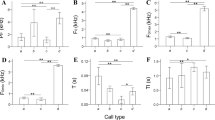Summary
The acoustic behaviour of 15 sympatric and synchronically breeding species of frogs in an area of floating meadows near Manaus (Brazil) was studied for a period of 8 months. The calling positions of each species can be identified with certain physiognomic types of vegetation.
Sound analyses were used to compare the mating calls. The main variables are dominant frequency, call duration and pulse repetition rate. Each of the 15 species has a distinct mating call and differs from the acoustic behaviour of each other one. Eleven species are separated in their dominant frequency ranges within their specific calling sites. Species sharing emphasised frequency ranges within identical calling sites differ greatly in at least two temporal variables.
The roles of calling position, spectral, and temporal features of mating calls in species recognition and premating reproductive isolation are discussed.
Similar content being viewed by others
References
Bellis, E.D.: The effects of temperature on salientian breeding calls. Copeia 1957, 85–89 (1957)
Blair, W.F.: Call difference as an isolation mechanism in Southwestern toads (Genus Bufo). Tex. J. Sci. 8, 87–106 (1956)
Blair, W.F.: Call difference as an isolating mechanism in Florida species of hylid frogs. Quart. J. Florida Acad. Sci. 21, 32–48 (1958)
Blair, W.F.: Isolating mechanisms and interspecies interactions in anuran amphibians. Quart. Rev. Biol. 39, 334–344 (1964)
Capranica, R.R.: The auditory system. In: Physiology of the amphibia, Vol. III (B. Lofts, ed.), pp. 443–466. New York-London: Academic Press 1976
Capranica, R.R., Frishkopf, L.S., Nevo, E.: Encoding of geographic dialects in the auditory system of the cricket frog. Science 182, 1272–1275 (1973)
Crump, M.L.: Quantitative analysis of the ecological distribution of a tropical herpetofauna. Occ. Pap. Mus. Nat. Hist. Univ. Kansas 3, 1–62 (1971)
Crump, M.L.: Reproductive strategies in a tropical anuran community. Misc. Publ. Mus. Nat. Hist. Univ. Kansas 61, 1–68 (1974)
Duellman, W.E.: Courtship isolating mechanisms in Costa Rican hylid frogs. Herpetologica 23, 169–183 (1967)
Duellman, W.E.: The hylid frogs of Middle America. Mong. Mus. Nat. Hist. Univ. Kansas 1, 1–753 (1970)
Duellman, W.E.: A reassessment of the taxonomic status of some neotropical hylid frogs. Occ. Pap. Mus. Nat. Hist. Univ. Kansas 27, 1–27 (1974)
Gerhardt, H.C.: Behavioral isolation of the tree frogs, Hyla cinerea and Hyla andersonii. Amer. Midl. Nat. 91, 424–433 (1974)
Goin, C.J., Layne, J.N.: Notes on a collection of frogs from Leticia, Colombia. Publ. Research Div., Ross Allen's Reptile Institute 1, 97–114 (1958)
Haffer, J.: Speciation in Amazonian forest birds. Science 165, 131–137 (1969)
Instituto Nacional de Pesquisas da Amazônia (INPA): Manaus, Brasil: Boletim meteorológico 1974, 1975 (unpublished reports)
Junk, W.: Investigations on the ecology and production-biology of the “floating meadows” (Paspalo-Echinochloetum) on the Middle Amazon. Part I: The floating vegetation and its ecology. Amazoniana 2, 449–495 (1970)
Littlejohn, M.J.: The systematic significance of isolating mechanisms. In: Systematic biology, Publ. 1692, pp. 459–493. Washington, D.C.: Nat. Acad. Sci. 1969
Martof, B.S., Thompson, E.F.: Reproduction behaviour of the chorus frog, Pseudacris nigrita. Behaviour 13, 243–258 (1958)
Schiøtz, A.: The tree frogs (Rhacophoridae) of West Africa. Spolia Zool. Mus. Hauniensis 25, 1–346 (1967)
Schneider, H.: Structure of the mating calls and relationships of European tree frogs (Hylidae, Anura). Oecologia (Berl.) 14, 99–110 (1974)
Vanzolini, P.E., Williams, E.E.: South American anoles: The geographic differentiation and evolution of the Anolis chrysolepis species group (Sauria, Iguanidae). Arq. Zool. S. Paulo 19, 1–124 (1970)
Author information
Authors and Affiliations
Rights and permissions
About this article
Cite this article
Hödl, W. Call differences and calling site segregation in anuran species from central Amazonian floating meadows. Oecologia 28, 351–363 (1977). https://doi.org/10.1007/BF00345990
Received:
Issue Date:
DOI: https://doi.org/10.1007/BF00345990




